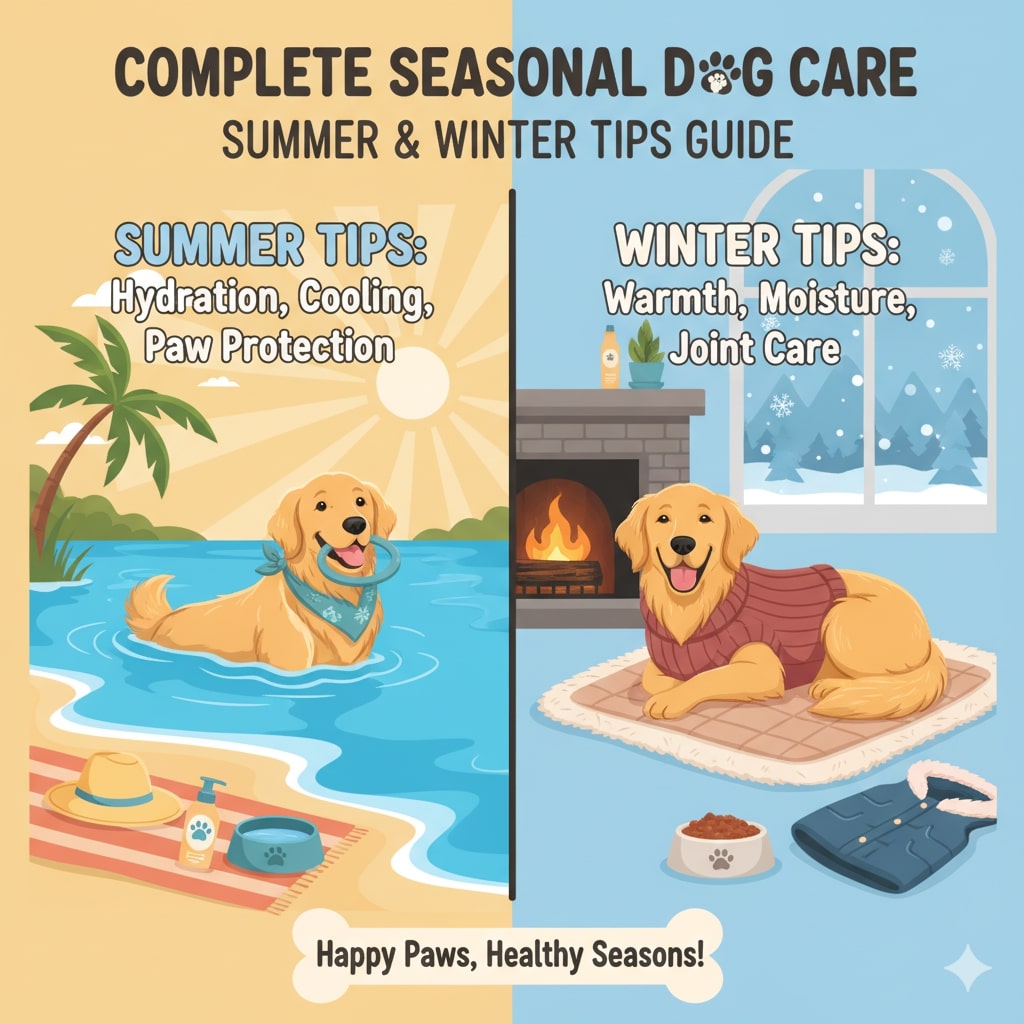Seasonal Dog Care Tips: Summer & Winter
Caring for your dog throughout the year requires understanding how seasonal changes impact their health, behavior, and overall well-being. Dogs, like humans, are sensitive to extreme weather, making it essential for pet owners to adjust their care routines during summer and winter. From hot summer days to freezing winter nights, each season presents unique challenges that can affect your dog’s comfort, energy levels, and safety. Complete Seasonal Dog Care should be know every pet owner’s.
This Complete Seasonal Dog Care Guide is designed for dog owners across the U.S. who want to ensure their pets remain healthy, happy, and active throughout the year. In this guide, you will discover practical tips on hydration, exercise, grooming, diet, and preventive care tailored to seasonal conditions. Learn how to protect your dog from heatstroke during the scorching summer months, and how to prevent cold-related health issues like hypothermia and dry skin in the winter.
Discover More: Ultimate Pet Care Guide for Pet Owners in the USA

Whether you have a playful puppy, an energetic adult dog, or a senior canine, these season-specific strategies will help you provide the best care possible. By following these tips, you can ensure that your dog not only survives but thrives no matter the season. Start preparing now to keep your furry friend comfortable, safe, and full of energy year-round.
Summer Season Dog Care Tips
Summer brings sunshine, outdoor adventures, and, unfortunately, potential hazards for your furry friend. Here’s how to keep your dog safe and comfortable during the warmer months:
1. Preventing Heatstroke
Heatstroke is a serious and potentially fatal condition in dogs. Unlike humans, dogs can’t sweat effectively to cool down. Here’s how to prevent it:
- Never leave your dog in a parked car: Even on a mild day, the temperature inside a car can rise rapidly to dangerous levels.
- Provide plenty of fresh water: Ensure your dog has access to cool, clean water at all times, especially when outdoors.
- Limit exercise during peak heat: Avoid strenuous activity during the hottest part of the day. Opt for early morning or late evening walks.
- Provide shade: When outdoors, ensure your dog has access to shade, whether it’s a tree, umbrella, or dog house.
- Recognize the signs of heatstroke: Excessive panting, drooling, weakness, vomiting, and collapse are all signs of heatstroke. If you suspect your dog has heatstroke, immediately move them to a cool place, offer water, and contact your veterinarian.
- Consider a cooling vest or mat: These can help regulate your dog’s body temperature during hot weather.
2. Paw Protection
Hot pavement can burn your dog’s paws.
- Test the pavement: Before walking your dog, place your hand on the pavement for five seconds. If it’s too hot for you, it’s too hot for your dog.
- Walk on grass or shaded areas: Whenever possible, walk your dog on grass or shaded areas to avoid hot surfaces.
- Use paw wax or booties: Paw wax can provide a protective barrier against hot pavement, while booties offer complete protection.
- Moisturize paws: Dry, cracked paws are more susceptible to burns. Regularly moisturize your dog’s paws with a paw balm.
3. Sun Protection
Just like humans, dogs can get sunburned, especially those with light-colored fur or short coats.
- Apply dog-safe sunscreen: Use a sunscreen specifically formulated for dogs on exposed areas like the nose, ears, and belly.
- Limit sun exposure: Avoid prolonged sun exposure during peak hours.
- Provide shade: Ensure your dog has access to shade when outdoors.
4. Water Safety
Swimming can be a great way for your dog to cool off in the summer, but it’s important to take precautions.
- Supervise your dog around water: Never leave your dog unattended near pools, lakes, or oceans.
- Teach your dog to swim: Not all dogs are natural swimmers. Introduce your dog to water gradually and teach them how to swim.
- Provide a life jacket: If your dog is not a strong swimmer or will be in deep water, provide a dog-specific life jacket.
- Rinse your dog after swimming: Rinse your dog with fresh water after swimming to remove chlorine, salt, or algae.
- Be aware of water hazards: Watch out for strong currents, undertows, and dangerous marine life.
5. Parasite Prevention
Summer is peak season for fleas, ticks, and mosquitoes, which can transmit diseases to your dog.
- Use preventative medications: Talk to your veterinarian about the best flea, tick, and heartworm prevention medications for your dog.
- Check your dog regularly for ticks: After spending time outdoors, check your dog thoroughly for ticks, especially in areas like the ears, neck, and between the toes.
- Keep your yard clean: Mow your lawn regularly and remove debris to reduce tick and mosquito habitats.
Winter Season Dog Care Tips
Winter brings its own set of challenges for dog owners. Here’s how to keep your dog safe and comfortable during the colder months:
1. Protecting from the Cold
Dogs, especially those with short coats or small breeds, are susceptible to hypothermia and frostbite in cold weather.
- Limit outdoor exposure: Shorten walks and playtime during extremely cold weather.
- Provide a warm coat or sweater: Dress your dog in a warm coat or sweater when going outside.
- Protect paws from ice and snow: Use paw wax or booties to protect your dog’s paws from ice, snow, and salt.
- Provide a warm bed: Ensure your dog has a warm and comfortable bed indoors, away from drafts.
- Monitor for signs of hypothermia: Shivering, lethargy, and weakness are signs of hypothermia. If you suspect your dog has hypothermia, warm them up gradually and contact your veterinarian.
2. Paw Care in Winter
Salt and de-icing chemicals can irritate and damage your dog’s paws.
- Wipe paws after walks: Wipe your dog’s paws with a damp cloth after walks to remove salt and chemicals.
- Use paw wax or booties: Paw wax can provide a protective barrier, while booties offer complete protection.
- Moisturize paws: Cold weather can dry out your dog’s paws. Regularly moisturize them with a paw balm.
- Trim fur between toes: Long fur between the toes can trap ice and snow, causing discomfort. Trim the fur regularly.
3. Winter Allergies
Just like humans, dogs can suffer from winter allergies. Dry indoor air can exacerbate skin problems.
- Humidify your home: Use a humidifier to add moisture to the air.
- Bathe your dog less frequently: Frequent bathing can dry out the skin.
- Use a moisturizing shampoo: When you do bathe your dog, use a moisturizing shampoo.
- Add omega-3 fatty acids to their diet: Omega-3 fatty acids can help improve skin health.
- Consult your veterinarian: If your dog’s allergies are severe, consult your veterinarian for treatment options.
4. Antifreeze Poisoning
Antifreeze is highly toxic to dogs. Even a small amount can be fatal.
- Store antifreeze safely: Store antifreeze in a sealed container out of reach of pets.
- Clean up spills immediately: Clean up any antifreeze spills immediately and thoroughly.
- Be aware of the signs of antifreeze poisoning: Vomiting, lethargy, and seizures are signs of antifreeze poisoning. If you suspect your dog has ingested antifreeze, contact your veterinarian immediately.
5. Exercise and Mental Stimulation
It’s important to keep your dog active and mentally stimulated during the winter months, even if outdoor activities are limited.
- Indoor games: Play fetch, tug-of-war, or hide-and-seek indoors.
- Puzzle toys: Provide puzzle toys to keep your dog mentally stimulated.
- Training sessions: Use the winter months to work on training and obedience.
- Doggy daycare: Consider doggy daycare for socialization and exercise.
By following these seasonal dog care tips, you can help your furry friend stay safe, healthy, and happy all year round. Remember to consult with your veterinarian for personalized advice and recommendations based on your dog’s individual needs.
⚠️ NOTE: This post is for informational purposes only. Please see our full Disclaimer Page for details.
